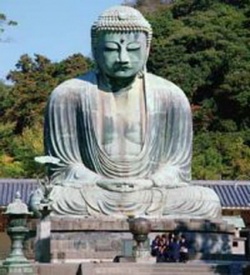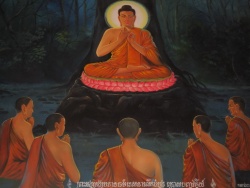The Universal Buddha of Light
Amida Buddha is the heart of Shin Buddhist faith and practice. First revealed by the historical Buddha over 2,600 years ago, the name Amida is Japanese which is derived from Amitabha or Amitayus of the ancient Sanskrit language, which means ‘Immeasurable Life and Light’ or Oneness. The word Amida is a personification or symbol for the transcendent reality and mystery, which is “unborn, uncreated and formless” which is also known as dharmakaya, nirvana, shunyata (emptiness).
As mentioned above, Amida Buddha is a personification expressing that which is incomprehensible. This inconceivable transcendent realm is called Dharmakaya, which is Sanskrit meaning ‘the body of truth.’ This word points to the non-conceptual ultimate dimension and the true nature of things including ourselves. Amida Buddha in turned is the sambhogakaya or the compassionate expression of this formless transcendent realm. She gives us a concrete image that helps us to understand that which is beyond understanding. Amida is also synonymous with the terms One Life, the Great Compassion and Buddha Nature. As stated above, Amida is a personification or symbol of ultimate reality and must be understood that ultimate reality is beyond the word and idea of Amida, who is the vehicle that allows us to experience the incomprehensible reality of our true nature.
As the comprehensible symbol of universal truth (dharma), Amida points to the nameless caring force or truth that surrounds and permeates us, ceaselessly working to awaken us to reality-as-it-is, which is Nirvana. She is considered the Great Parent offering unconditional love and universal compassion that assures spiritual liberation for all. Through this living power of love and compassion, no one is left behind to suffer endless cycles of births and deaths and there is certainly no such thing as a final judgment, end times or eternal hell. On the contrary, because of Amida Buddha's unconditional love and compassion, all beings are liberated just as they are.
Buddha is a term meaning a few things: firstly, it is any life form that has awakened to boundlessness; secondly, it is the deepest nature of all things, which is undifferentiated and selfless; and thirdly, it is our inner potential, reality and destiny to live a life of pure compassion and wisdom.
Amida: Different Vision of God
Shin Buddhism’s view on ultimate reality or God may be considered panentheistic. The term panentheism means “all within God (theos)” which means everything including ourselves is within God, but God is more than all of the components. This is exactly the Buddhist view but there is a big problem with this word; Buddhists don’t believe in a personal God. Instead we suggest a couple of new terms, as first coined by G.R. Lewis, that better describe our view of ultimate reality: panendharmism (all within dharma) or panenbuddhism (all within Buddha).
So what is panenbuddhism? Simply put, all things are within and part of ultimate reality, known as dharmakaya, which is an interpenetrating and boundless unfolding web of pure consciousness (pure awareness), personified as Amida. However, Amida is more than the sum of all of its components.
Everything in life is co-manifesting and intimately interpenetrating with everything else and has its ultimate reality in everything. That is to say, this dynamic reality is in constant flux and nothing has a stable eternal nature. There is no individual self or absolute identity but all things are temporary phenomena and are full of the totality, the Oneness of reality, personified as Amida Buddha. In Buddhism, this reality is known as shunyata or emptiness.
However, as stated above, Amida, as the personification of the dharmakaya, is more than the sum of all things. Reality is akin to a hologram that has been broken into countless pieces. Each broken bit contains the entire holographic image, and everything intimately reflects the light and life and everything else. Nevertheless, each bit cannot exactly claim to be the summation of all the broken pieces. What is important to realize is that everything, including what we consider vile and dark, is part of the endless web of existence and nothing and nobody is excluded. This is important in our understanding of the Shin Buddhist view of universal salvation. Please refer to the Amida as the One Life web page for a complete explanation.
All religions offer a sacred or mythical story so that ordinary people can understand that which is incomprehensible. For example, there are stories of virgin births, crucifixions, visits by angels, ascensions through heavens and resurrections. Some may dismiss myth as false or just nice little stories but in reality, myth serves as the medium by which our inner deep subconscious mind interacts with our outer conscious mind and world. Myths manifest themselves in a dreamlike manner, coming from our wisdom bodies, the human body, whose source is the ground of our biological being, the source of life.
One major difference between Western and Middle Eastern religions and Shin Buddhism is that we (Buddhists) freely acknowledge that our sacred story is a metaphor and not historical fact. To see it as true history would be to miss the point and be a grave error. As the Buddha said, “it is the finger that points to the moon,” The finger is not the moon but indicates the direction of the moon. So many people get confused thinking that the finger is the moon (truth).
The Sacred Story of Shin Buddhism is a saga of great love, compassion, sacrifice and triumph. It is derived from the Larger Sutra of Immeasurable Life, which uses mythical language and metaphor (symbols) to convey the unexplainable nature of nirvana, the universal enlightened reality and its primordial activity, which is beyond conceptual thought. That is to say, the Sacred Story is not to be read as literal truth but as a metaphor that points to the ceaseless activity of universal compassion and the foundation of reality itself, which is ultimately our true nature. In many religions, symbols tend to be concretized into facts; God becomes a fact or religious scriptures are seen as the literal truth. However, according to Buddhism, these are just symbols to direct the mind and heart to shunyata (emptiness) which is beyond form, beyond thought and beyond comprehensibility.
In The Larger Sutra of Immeasurable Life, the main Shin Buddhist scripture, the historical Buddha tells Ananda, one of his chief disciples, the legendary story that took place in timeless time. In this sacred story, there was a prince called Dharmakara, which means Storehouse of the Dharma, who like the true historical Prince Siddhartha Gautama or Shakyamuni, renounced his royal position, and became a bhikshu, a renunciant spiritual seeker. His reason for pursuing the religious life was motivated by his great compassion and deep love for all suffering beings throughout the universe and time. Due to his pure love and compassion, Dharmakara declared 48 religious vows, called collectively as the Primal Vow, in order to create a Pure Land that would liberate each and every suffering being throughout time and space.
A Pure Land, or Sukhavati in Sanskrit, is the transcendent realm totally free of greed, anger and delusion, which is open to all without exception. In Shin Buddhism, the Pure Land is identical with Nirvana, the abode of peace and infinite life, which is not a specific place but is the ultimate dimension of eternal oneness (non-duality), being everywhere, within everyone, and yet is nowhere.
Over a period of billions of years, he underwent numerous practices and alas he spiritually evolved to realize the awakening and liberation of both himself and all sentient beings within boundless space and time. By accomplishing his Primal Vow, the Pure Land became a reality and thus he became Amida, the Buddha of Immeasurable Life and Light.
Hence, Amida manifest herself in all quarters of the universe as the nembutsu- Namu-Amida-Butsu and through her Name, she nurtures all living beings and ceaselessly works to awakened them to reclaim their spiritual inheritance of enlightenment and be spiritually reborn in the Pure Land in the here and now.
At first, the Sacred Story may seem a little bizarre but once you begin to read the dharma, reflect on it, live the nembutsu and manifest shinjin, as the experience of awakening, more and more of the metaphors will be understood and appreciated and truly lived. Only then, will you will come to realize that this Sacred Story is actually the story of your own spiritual journey. How can this be? Please refer to the Nembutsu and Amida: the One Life web pages for the answer.



